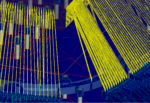Automatic adaptive meshing in Ansys HFSS is a critical component of its finite element method (FEM) simulation process. Guided by Maxwell’s Equations, it efficiently refines a mesh to deliver a reliable solution, guaranteed. Engineers around the world count on this technology when designing cutting-edge electronic products.… Read More
Tag: ansys
Can you Simulate me now? Ansys and Keysight Prototype in 5G
Ansys and Keysight wanted to see if they could answer the question, If we put virtual cellphones in different locations in a city, can we predict what kind of 5G signal we’re going to get in those locations? To find out, they created and tested a detailed virtual model of a city, including a variety of 5G antennae, receivers, and transmitters… Read More
Is Ansys Reviving the Collaborative Business Model in EDA?
The Electronic Design Automation (EDA) industry used to be a bustling bazaar of scrappy startups, along with medium sized companies that dominated a technology space, and big main-line vendors. The annual Design Automation Conference was noisy, hectic, and sprawled over multiple large convention halls. This diversity meant… Read More
A Practical Approach to Better Thermal Analysis for Chip and Package
Thermal modeling has become a hot topic for designers of today’s high-speed circuits and complex packages. This has led to the adoption of better and more sophisticated thermal modeling tools and flows as exemplified in this presentation by Micron at the IDEAS Digital Forum. The presentation is titled “Thermal Aware Memory Controller… Read More
Ansys CEO Ajei Gopal’s Keynote on 3D-IC at Samsung SAFE Forum
System on chip (SoC) based design has long been recognized as a powerful method to offer product differentiation through higher performance and expanded functionality. Yet, it comes with a number of limitations, such as high cost of development. Also, SoCs are monolithic, which can inhibit rapid adaptation in the face of changing… Read More
Big Data Helps Boost PDN Sign Off Coverage
The nearly unavoidable truth about dynamic voltage drop (DVD) signoff for power distribution networks (PDN) is that the quality of results depends on the quality and quantity of the vectors used to activate the circuit switching. As SOCs grow larger and are implemented on smaller nodes, the challenges of sufficient coverage … Read More
Bonds, Wire-bonds: No Time to Mesh Mesh It All with Phi Plus
Automatic adaptive meshing in HFSS is a critical component of its advanced simulation process. Guided by Maxwell’s Equations, it efficiently refines the mesh to accurately capture both the geometric and electromagnetic detail of a design. The end result is a process that guarantees accurate and reliable simulation results… Read More
Optical I/O Solutions for Next-Generation Computing Systems
According to DARPA the fraction of total power consumed in semiconductors for I/O purposes as been growing rapidly and is creating an I/O power bottleneck. It has reached the point where it needs to be addressed with new technologies and approaches. Interestingly, while the energy density, as measured by pJ/bit for short reach… Read More
Neural Network Growth Requires Unprecedented Semiconductor Scaling
The truth is that we are just at the beginning of the Artificial Intelligent (AI) revolution. The capabilities of AI are just now starting to show hints of what the future holds. For instance, cars are using large complex neural network models to not only understand their environment, but to also steer and control themselves. For… Read More
Ansys Talks About HFSS EM Solver Breakthroughs
Ansys HFSS™ has long enjoyed industry respect as a highly accurate electromagnetic simulator suitable for general purpose applications. Ansys has worked over the years to maintain its gold reference accuracy, and also to dramatically improve its performance and ease of use. A very interesting review of the key technology breakthroughs… Read More










